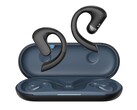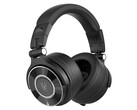
OpenRock Link 20 open-ear earphones hands-on: Powerful in-call noise cancelling
Clear calls.
The OpenRock Link 20 open-ear earphones use a 5-mic in-call AI noise reduction system, which includes a boom mic for clear calls in very noisy environments. A lightweight design with soft silicone-covered ear hooks enables all-day wear without creating pressure hot spots.David Chien Published 🇫🇷 🇪🇸 ...
Verdict - Great for all-day video meetings

The OpenRock Link 20 is squarely targeted at everyday use by office workers and students. Its audio tuning emphasizes clear vocal reproduction at all sound levels, making it a very good choice for video calls, learning languages, and reviewing lectures.
Thanks to four internal microphones and an external boom mic, voices remain intelligible even in noisy coffee shops during video meetings. The smoothly sculpted design and silicone-coated ear hooks were comfortable during all-day wear without creating pressure hot spots.
It has no support for high-resolution music codecs and its open-ear design means there is no thundering low-bass, but the rectangular drivers manage to fill the mid to lower treble range quite well, with a wide stereo soundstage.
Pros
Cons
Price and availability
The OpenRock Link 20 earphones with boom mic have an MSRP of $149.99. Extra boom mics can be purchased at an MSRP of $29.99 each. Readers can take advantage of Super Early Bird offers on Kickstarter starting September 23, 2025, for additional savings.
Table of Contents
- Verdict - Great for all-day video meetings
- Specifications
- Package contents
- Design – Excellent, comfortable fit
- Controls – A single multifunction button
- Initial connection – Supports dual-device pairing
- Smartphone app – Ample sound settings
- Charging Case - Strong enough to sit on
- Sound – Clear vocals with excellent calls
- Conclusion
The OpenRock Link 20 open-ear earphones are geared towards office workers and students who need clear in-call voice quality even in noisy environments. Its smooth design and silicone-covered ear hooks enable comfortable all-day wear without creating painful pressure spots. The Link 20's audio tuning prioritizes intelligible vocals at all sound levels, making it easier to understand bosses and teachers.
Specifications
| Drivers | 15 x 10 mm (0.6 x 0.4 in.) |
| Driver Power | 30 mW |
| Sound pressure level | 98±2 dB |
| Microphones | Two MEMS microphones in each earphone |
| One magnetic ECM boom microphone | |
| Connectivity | Bluetooth 6.0 wireless |
| Codecs | SBC, AAC |
| Battery | 62 mAh Li-ion polymer (earphones) |
| 550 mAh Li-ion polymer (case) | |
| Runtime | Talk: 9 hours (40 hours with charging case) |
| Music: 13 hours (52 hours with charging case) | |
| Charging | Full charge: 1.5 hours |
| Quick charge: Adds 1 hour of use in 5 minutes | |
| Ingress protection | Boom mic: IP55-rated against dust ingress and water jets |
| Earphones: IPX7-rated against water immersion to 1m/3.3ft. for 30 minutes | |
| Dimensions | Earphone: 52.03 x 43.07 x 17.63 mm (2.0 x 1.7 x 0.7 in.) |
| Boom Mic: 71 mm (2.7 in.) long | |
| Case: 104 x 52.6 x 27.5 mm (4.1 x 2.1 x 1.1 in.) | |
| USB-C cable: 277 mm (11 in.) long | |
| Button sizes | Earphone: ~5 x 2 mm (0.20 x 0.08 in.) |
| Weight | Earphone: 9 +/- 0.2 g (0.32 +/- 0.007 oz.) |
| Boom Mic: 1.5 +/- 0.2 g (0.05 +/- 0.007 oz.) | |
| Case: 60 g (2.12 oz.) |
Package contents
The packaging included the OpenRock Link 20 earphones, charging case, documentation, and a USB-C charging cable. The optional smartphone app can be downloaded from the Apple App Store or Google Play Store.
Design – Excellent, comfortable fit
The OpenRock Link 20 ear hangers are covered in soft silicone. The hangers are very flexible thanks to the titanium wires inside them and can be hooked onto the ears with ease. Both earphones and eyeglasses can be taken off or worn without interfering with each other. The earphones are very comfortable to wear, even while sleeping, with no need to insert ear tips or clean earwax off them.
The OpenRock design created no pressure hot spots, with no heat and moisture buildup, across weeks of testing. The lightweight earphones were practically unnoticeable, even causing the reviewer to question at times whether they were present.
The Link 20’s fit was excellent. They did not slip or require adjustment during hours of video meetings or music listening. The earphones remain in place when jogging, but they will come off when shifting about during sleep or headbanging to hard rock.
The magnetic boom mic attaches to two contact points on the bottom of either earphone. Once attached, the Link 20 automatically changes the EQ to Voice mode and announce this. The magnets are strong enough to keep the mic attached even while exercising.
Controls – A single multifunction button
A single control button is located at the top of each earphone—small but easy to find by feel. A single press toggles music play and pause, and multiple presses activate other functions, some of which can be user-programmed. The function triggering is time sensitive, so pressing too slowly won’t activate the desired function.
A single press either answers/hangs up calls or plays/pauses music. A double press either rejects calls or skips music tracks (right earphone—next, left—prior). These functions cannot be customized.
A triple press, quadruple press, and long press can all be set in the app to activate one of the following functions: Volume +, Volume -, Redial, EQ mode, and Voice Assistant.
Identical presses on either earphone can be set to activate different functions. However, the user cannot adjust the volume properly when wearing only one earphone if both Volume + and Volume – functions are not programmed into that unit.
Initial connection – Supports dual-device pairing
The OpenRock Link 20 pairs with Bluetooth devices easily—turn it on, wait for the voice prompt, then search for ‘OpenRock’. The earphones connect in standard SBC or AAC codec mode, depending on the audio device. Although neither is a high-resolution codec like LDAC, Android users can force the use of SBC by adding ‘_NOAAC’ to the OpenRock device name in the Bluetooth device settings.
The earphones do not have a low-latency connection mode, so the audio may be noticeably out of sync with the video if the player software does not compensate for this. During testing on an LG G7 smartphone, YouTube videos played in sync in the Chrome browser, but those in the VLC app required a latency adjustment of -350 msec.
When connected to Android phones with ‘Disable absolute volume’ checked in Developer Options, the Link 20 is able to drop the volume to below whisper levels, perfect for falling asleep to while listening to very quiet ASMR.
Smartphone app – Ample sound settings
The optional smartphone app can be downloaded from the app stores and provides access to a wide range of headphone settings.
The app includes the ability to adjust EQ settings (Music, Voice, Beast, or Custom 7-band EQ), activate Spatial Sound, adjust Sound Balance, set Auto Power Off timers (15, 30, or 60 min), set Over-time Wear reminders (30 min, 1 hr, 2 hr, or 4 hr), limit Maximum Volume (80 dB, 86 dB, or 92 dB), and set the voice prompt language to English or Chinese. The app can also play a continuous, high-pitched sound through the earphones to help find them.
Charging Case - Strong enough to sit on
The OpenRock Link 20 earphones recharge automatically when placed in the charging case, which is strong enough to be sat on. Magnets hold the boom mic and earphones securely even when the open case is held upside down. The front of the case has a charge level indicator light, and the back has a USB-C port and Bluetooth pairing/factory reset button.
The front LED will light when the case is opened – blue when the charge level is over 20% and red when the charge level is under that. The case can be connected to any USB-C power source, and the front light will pulse during charging.
The earphones used approximately 15% of their battery after eight hours of standby. They used less than 60% of their battery when used for calls and music throughout each eight-hour workday. During testing, recharging from 45% to 100% took about 30 minutes while reducing the case charge level from 100% to 89%.
Runtimes will vary depending on use case, Bluetooth connection, battery age, and other factors.
Sound – Clear vocals with excellent calls
Calls
The OpenRock Link 20 utilizes a multi-mic system with AI in-call noise reduction technology.
The earphones have two MEMS mics in each unit and are quite good on their own in cancelling out background noise. In noisier environments, intelligibility with these four mics suffers a touch, and voices sound more muffled. When the magnetic boom mic is attached, the proximity of this mic to the mouth helps the system to better isolate the voice while retaining higher intelligibility and sound quality.
The Link 20 automatically switches to Voice mode when the boom mic is attached, helping ensure the clarity of voices heard during calls. Voices heard sound full and never shrill, even at maximum volume. This makes the Link 20 an excellent choice for all-day meetings and calls because the ears do not fatigue much at all.
During testing, whether standing behind a roaring V-12 Audi R8 exhaust or next to a large water fountain in a public space, every spoken word captured by the boom mic was intelligible and background noise was significantly reduced. These are extreme use cases since most owners will be participating in video meetings at a café or office.
Studying and transcriptions
The OpenRock Link 20 reproduces voices very clearly, especially speakers with accents or using foreign languages. This makes them an excellent choice for audio transcription, language learning, and listening to lectures, meetings, and podcast recordings.
Because of their open-ear design, music played at 50% volume would generally not be audible at 1 meter (3.3 ft.) or greater, but is above 60% in quiet environments like libraries.
Spatial Sound mode
The Spatial Sound mode adds a sense of space, so a film scene like the rooftop shootout at the end of American Sniper sounds like it was being viewed in a large theater. But, the OpenRocks do not reproduce spatial music well, including Sony 360 Reality Audio recordings, because they fail to properly localize sounds above, below, in front, or behind listeners.
Music
The OpenRock Link 20 earphones are targeted for office and school calls, so with their open-ear design, there is no meaningful low-bass. This is never missed during calls, but noticeable in some music tracks that depend on it. For example, the lack of low-bass saps the rhythmic strength of the gamelan jegog instruments in Kaneda from the Akira movie soundtrack. The lack of high-end audio prowess and low-end bass also leads to a rare stumble in Miliyah Kato’s Bad Chasing, where the introduction of drums at 1:15 results in an ugly-sounding bass line that oversteps her vocals rather than remaining in the background.
While they can’t match the sonic reproduction of the best earphones, the Link 20 earphones can reproduce audio with a good sense of stereo presence that is smooth, rarely harsh, and never shrill. One can listen to them all day long with very low ear fatigue at work. The rectangular drivers have enough power to reproduce the midrange to lower-treble frequencies with a satisfying fullness much like the muzak played in the background of luxury shopping stores – engaging and lively, but never in your face with hard bass like a dance club.
Importantly, vocals in Music mode are forward and clear, rarely overwhelmed by the instruments. Charlotte Church’s Requiem: Pie Jesu, Chara and Yuki’s Yoppite, Elton John & Dua Lipa’s Cold Heart, and Twice’s Fancy showcase the Link 20’s ability to carve out a space for vocals, retaining excellent intelligibility for those wanting to learn the lyrics.
Unlike closed-back headphones, the open-ear OpenRocks create a wide stereo soundstage. These two factors make songs that pair wide stereo placement of instruments with top vocal talent like Michael Jackson’s Billie Jean particularly enjoyable.
Conclusion
The lightweight OpenRock Link 20 proved to be very satisfying earphones to wear during weeks of testing, thanks to their immediately comfortable ear hooks and powerful 5-mic in-call noise-cancelling that produced intelligible voices in noisy environments.
Transparency
The selection of devices to be reviewed is made by our editorial team. The test sample was given to the author by the manufacturer free of charge for the purposes of review. There was no third-party influence on this review, nor did the manufacturer receive a copy of this review before publication. There was no obligation to publish this review. As an independent media company, Notebookcheck is not subjected to the authority of manufacturers, retailers or publishers.



































